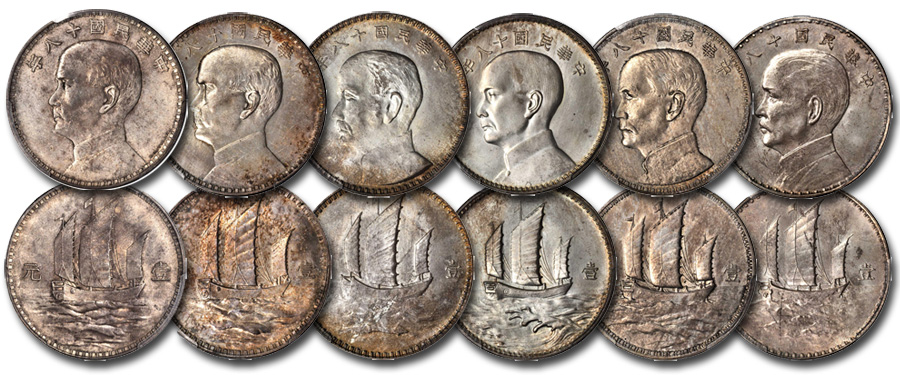
Vintage Chinese coins continue to perform well at auction, and we are
pleased to offer in our upcoming Stack’s Bowers and Ponterio April Hong Kong
Showcase Auction a terrific run of vintage pieces, including the Sun Yat-sen
pattern Dollars from each of the foreign mints that produced them. In 1929, the Chinese Ministry of Finance ordered a new
design for the then proposed Dr. Sun Yat-sen Dollar. Patterns were submitted
from five of the world’s leading mints: Rome, Italy; Osaka, Japan; the Royal
Mint in London, England; Philadelphia, United States and Vienna, Austria.
Subtle variations are present, though each of the five mints produced pattern
coinage following a basic design. Ultimately the Chinese authorities settled on
the obverse pattern designed by Italian engraver Attilio Motti, with some
subtle alterations by John Sinnock, the chief engraver of the Philadelphia Mint.
The reverse design received the most changes before completion. The patterns
produced by the world mints depicted a junk boat with three sails, while the
final circulation issues struck by the Chinese featured a junk boat with just
two sails. It is interesting to note that some aspects of the various patterns
left room for interpretation on the part of the designer, most notably the
portrait, while other elements such as the denticles must have been a specific
design requirement as they are nearly identical on all patterns regardless of
origin.
Attilio Motti designed two patterns for this type, one
with and one without his signature (both types can be found in this sale). The
signed type – as is the case for all Chinese patterns bearing his signature –
is scarcer and more desirable than the unsigned type. The other engravers for
their respective countries are also known to us, including Langford Hughes of
the British Royal Mint, operating with instructions from the Chinese Legation
in London. The British example features a prominent and highly stylized wave
that resembles a hand reaching up from a grave. Some countries were not so
eager to reveal their involvement, such as the mint in Osaka, Japan. When
composing his Catalog of Chinese Coins Eduard Kann reached out to the mint
officials at the Osaka mint concerning this design type. Though the Osaka mint
asserted it had no knowledge or involvement in this issue, Kann remains
resolute in associating this design with the Osaka mint. The mint in Vienna,
Austria asked Richard Placht to engrave dies but then sent the dies to the
Hangchow, China where the coins were struck. The Austrian design features a
portrait of Sun Yat-sen with vague German or Aryan influences, especially in
the hairline, setting the Austrian pattern apart from the other designs. The
pattern designed at the Philadelphia Mint was also sent to Hangchow, China for
striking.
The pattern coins all follow the same basic design points
requested by the Chinese Ministry of Finance. The obverse shows the head of Dr.
Sun Yat-sen in profile facing left, with the Chinese inscription above stating:
“18th Year of the Republic of China.” The reverse design bears an image of a
junk boat with three sails facing left atop a slightly choppy seascape. Two
characters enumerating the denomination appear at either side of the junk
design. As mentioned earlier, each country put its own twist on the design, be
it a signature, stormy sea or a distinctive portrait.
Though our Stack’s Bowers April Hong Kong Showcase Auction is no longer
open for consignments, we are now accepting consignments of world and ancient
coins for our August 2016 ANA Auction as well as Chinese and other Asian coins
and currency for our August 2016 Hong Kong Showcase Auction. Time is running
short, so if you are interested in consigning your coins and paper currency
(whether a whole collection or a single rarity) be sure to contact one of our
consignment directors.





